Heintz'
Textbook
Airfoils
- An Application
By Chris
Heintz
[This article is part 4 of
a series, where aeronautical engineer Chris Heintz
continues his discussion on airfoil design with a look at
the application on the STOL CH 701, and how the airfoil
contributes to the STOL characteristics of an aircraft.]
In the last series of articles we have
tried to grasp an understanding of airfoils - the sections of
the wings which keep our airplanes airborne due to the lift
provided by the airfoil geometry and the speed at which they
move through the air.
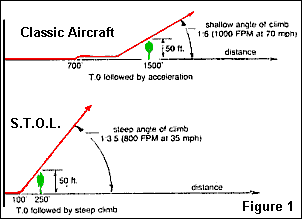 We have seen that without undue sophistication
we can design an airfoil which provides a very high lift
which will allow us to fly surprisingly slow. In other words.
with a relatively small wing area and within a given weight,
we can take off and land in a very short distance because we
do not need to accelerate or decelerate to or from a high
speed. We have also seen that the proposed airfoil has a
favorable lift to drag ratio at high lift; this allows the
aircraft to climb out or come in at a very steep angle
allowing following performance such as shown in figure 1.
We have seen that without undue sophistication
we can design an airfoil which provides a very high lift
which will allow us to fly surprisingly slow. In other words.
with a relatively small wing area and within a given weight,
we can take off and land in a very short distance because we
do not need to accelerate or decelerate to or from a high
speed. We have also seen that the proposed airfoil has a
favorable lift to drag ratio at high lift; this allows the
aircraft to climb out or come in at a very steep angle
allowing following performance such as shown in figure 1.
Keep in mind, however, that to obtain
full advantage from the airfoil, both flaps and slats should
extend full span over the whole wing.
The first idea will be to build one of
those fantastic wings, design a mechanism to allow full span
flaperons (flaps and ailerons combined in one full span unit
and controllable as flaps with the flap control and as
ailerons with the classic aileron control through a so called
"mixer") ... and install this new wing on an
existing aircraft. Although the idea sounds good, this is too
simplistic of an approach. Remember, I have already warned
that the addition of slats on any given wing will bring the
aircraft "out of balance." In the present case,
although the balance will be 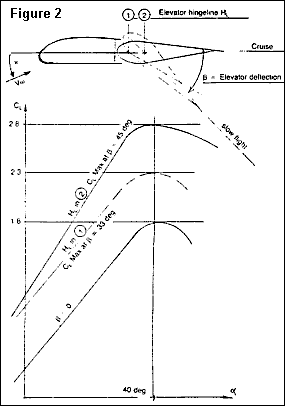 correct, we have forgotten that the high lift is
achieved at an unusually high angle of attack (25 to 30
degrees versus the classic 15 to 18 degrees.)
correct, we have forgotten that the high lift is
achieved at an unusually high angle of attack (25 to 30
degrees versus the classic 15 to 18 degrees.)
To achieve this high angle of attack,
the fuselage geometry must allow ground clearance at take off
and on landing (see figure
2). From this standpoint, a
tricycle landing gear is a big plus - apart from the fact
that in normal ground position the wing has a smaller
incidence with a tricycle gear than a taildragger and will be
less sensitive to high (cross) wind taxiing.
But correct fuselage geometry is not
all that is needed. Pitch control must be able to effectively
control the incidence even at the high angles associated with
slow flying. That means the horizontal tail must be able to
push the tail down in order to lift the nose up and keep the
angle of incidence high for those sustained high angle
climbs.
Of course, I hear some of you talking
canard, but don't forget that the downwash behind the wing
will help a classic tail - but it will have no effect in the
front!
No, what we need is a horizontal tail
with a high negative lift; that is why it is "upside
down." The elevator is designed to provide a certain
"funnel effect" when deflected - see figure 3. The Zenair STOL CH-701 horizontal tail has a
negative maximum lift coefficient of 2.8 when the elevator is
deflected 40 degrees. But, for all this to be effective, the
tail must be set so that in cruise the drag is minimized by
having the elevator in line with the stabilator, and the
whole tail airfoil at an incidence compatible with the
general airflow at this location within the downwash of the
wing.
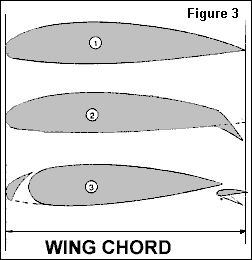 And a few more details that are important to
remember when designing a STOL aircraft are as follows:
And a few more details that are important to
remember when designing a STOL aircraft are as follows:
- The landing gear must be stronger
than average. Human nature being what it is, the
pilot, knowing he has the ability to land in a very
short distance may take advantage of this desirable
feature and "plunk" his aircraft down in an
unprepared 'pea patch,' resulting in some hard knocks
for the landing gear to absorb.
- Visibility must be even better
than with other aircraft designs because of the large
variations in incidence. Slow flying may bring you in
the way of faster aircraft, but remember with a STOL
aircraft you are more maneuverable and have an
advantage to give way – see figure 4
for an illustration of the visibility available in
the STOL CH 701.
- Excellent controllability at very
low flying speed is absolute necessity. Pitch
control is automatically good due to the required
horizontal tail design (see again figure 3).
Roll control is not bad with full span
ailerons by, again, use of the 'funnel effect' '
Instead of plain flaperons, carefully designed
"Junker" type flaperons provide excellent
roll control at low speeds without much drag penalty
in cruise. (See figure 5)
Good yaw control can easily be
achieved with an "all flying rudder" (see again figure 2). This relatively large moving vertical surface
gives plenty of control in a crosswind, in the air as well as
on the ground.
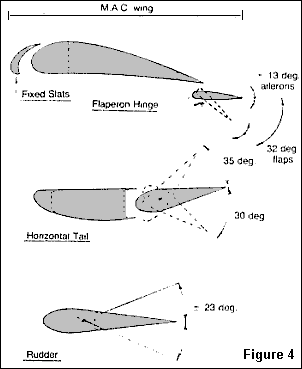 And,
finally, a strong airframe (6 g) is necessary so that the
pilot does not have to fear losing a wing, which might be
associated with the very light structure (430 lbs. for the
Zenair STOL CH 701) used so that a low horsepower engine (50
to 100 BHP) can be used to obtain outstanding take off
performance.
And,
finally, a strong airframe (6 g) is necessary so that the
pilot does not have to fear losing a wing, which might be
associated with the very light structure (430 lbs. for the
Zenair STOL CH 701) used so that a low horsepower engine (50
to 100 BHP) can be used to obtain outstanding take off
performance.
These are the trade marks of a good
two-seat design.
As already discussed in a previous
article, pilot comfort, crashworthiness and an easy-to-build,
long lasting airframe are simply routine items required when
designing a new generation aircraft, for which there is
apparently a need as shown by the success of the Zenair STOL
CH 701.
One question which frequently crops up
is:
How can we increase the cruise speed of the aircraft?
With the 65-hp Rotax 582, the Zenair STOL CH-701 at full
gross stalls at 28 mph, cruises at 74 mph (with a top speed
of 82 mph). Considering that the cruise speed is 2-1/2 times
the stall speed, this is not bad at all. Even retracting the
slats would not increase the cruise very much. The apparatus
needed to make this change work are complicated and heavy
and, above all, would require an additional control.
Considering the 50 or so hours most of us recreational pilots
fly per year, we already have our hands full without this
additional control. It would be catastrophic to pull
"in" at the wrong time . . . and an automatic
device is even more complicated.
"Keep it simple and it works"
is my motto. If you want to fly faster, there are other good
designs. For example, the two seat Zenair Zodiac stalls at 44
mph and cruises at 105 mph, with the same horsepower as the
STOL CH 701.
Next time we will take an in-depth look
at wing tips and how they contribute to airfoil performance.
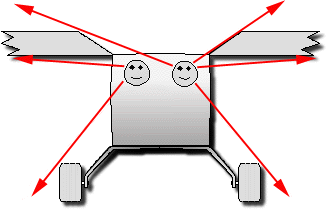
This article is presented as
part of a series, where aeronautical engineer Chris Heintz
discusses the technical aspects of his light aircraft designs
in laymen terms.
This article is part 4 of his
discussion series on airfoil design for light aircraft, and
was first published in EAA Experimenter magazine (June 1987).
© 1987, Chris Heintz.
See also:
"Anatomy of a STOL Aircraft: Designing a Modern Short Take-Off and
Landing Aircraft." by Chris Heintz
[Back] [Chris Heintz Design College]
|

Zenith Aircraft
Company
Mexico Memorial Airport, PO Box 650
Mexico, Missouri, 65265-0650 USA.
Tel: 573-581-9000 (Mon - Fri, 8-5 Central),
Fax: 573-581-0011
Comments or questions? Click Here |
© Zenith
Aircraft Company: 2006-03-30
 We have seen that without undue sophistication
we can design an airfoil which provides a very high lift
which will allow us to fly surprisingly slow. In other words.
with a relatively small wing area and within a given weight,
we can take off and land in a very short distance because we
do not need to accelerate or decelerate to or from a high
speed. We have also seen that the proposed airfoil has a
favorable lift to drag ratio at high lift; this allows the
aircraft to climb out or come in at a very steep angle
allowing following performance such as shown in figure 1.
We have seen that without undue sophistication
we can design an airfoil which provides a very high lift
which will allow us to fly surprisingly slow. In other words.
with a relatively small wing area and within a given weight,
we can take off and land in a very short distance because we
do not need to accelerate or decelerate to or from a high
speed. We have also seen that the proposed airfoil has a
favorable lift to drag ratio at high lift; this allows the
aircraft to climb out or come in at a very steep angle
allowing following performance such as shown in figure 1. correct, we have forgotten that the high lift is
achieved at an unusually high angle of attack (25 to 30
degrees versus the classic 15 to 18 degrees.)
correct, we have forgotten that the high lift is
achieved at an unusually high angle of attack (25 to 30
degrees versus the classic 15 to 18 degrees.) And a few more details that are important to
remember when designing a STOL aircraft are as follows:
And a few more details that are important to
remember when designing a STOL aircraft are as follows: And,
finally, a strong airframe (6 g) is necessary so that the
pilot does not have to fear losing a wing, which might be
associated with the very light structure (430 lbs. for the
Zenair STOL CH 701) used so that a low horsepower engine (50
to 100 BHP) can be used to obtain outstanding take off
performance.
And,
finally, a strong airframe (6 g) is necessary so that the
pilot does not have to fear losing a wing, which might be
associated with the very light structure (430 lbs. for the
Zenair STOL CH 701) used so that a low horsepower engine (50
to 100 BHP) can be used to obtain outstanding take off
performance.
